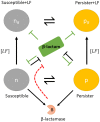Optimal dose of lactoferrin reduces the resilience of in vitro Staphylococcus aureus colonies
- PMID: 35960734
- PMCID: PMC9374217
- DOI: 10.1371/journal.pone.0273088
Optimal dose of lactoferrin reduces the resilience of in vitro Staphylococcus aureus colonies
Erratum in
-
Correction: Optimal dose of lactoferrin reduces the resilience of in vitro Staphylococcus aureus colonies.PLoS One. 2024 Aug 22;19(8):e0307969. doi: 10.1371/journal.pone.0307969. eCollection 2024. PLoS One. 2024. PMID: 39172960 Free PMC article.
Abstract
The rise in antibiotic resistance has stimulated research into adjuvants that can improve the efficacy of broad-spectrum antibiotics. Lactoferrin is a candidate adjuvant; it is a multifunctional iron-binding protein with antimicrobial properties. It is known to show dose-dependent antimicrobial activity against Staphylococcus aureus through iron sequestration and repression of β-lactamase expression. However, S. aureus can extract iron from lactoferrin through siderophores for their growth, which confounds the resolution of lactoferrin's method of action. We measured the minimum inhibitory concentration (MIC) for a range of lactoferrin/ β-lactam antibiotic dose combinations and observed that at low doses (< 0.39 μM), lactoferrin contributes to increased S. aureus growth, but at higher doses (> 6.25 μM), iron-depleted native lactoferrin reduced bacterial growth and reduced the MIC of the β-lactam-antibiotic cefazolin. This differential behaviour points to a bacterial population response to the lactoferrin/ β-lactam dose combination. Here, with the aid of a mathematical model, we show that lactoferrin stratifies the bacterial population, and the resulting population heterogeneity is at the basis of the dose dependent response seen. Further, lactoferrin disables a sub-population from β-lactam-induced production of β-lactamase, which when sufficiently large reduces the population's ability to recover after being treated by an antibiotic. Our analysis shows that an optimal dose of lactoferrin acts as a suitable adjuvant to eliminate S. aureus colonies using β-lactams, but sub-inhibitory doses of lactoferrin reduces the efficacy of β-lactams.
Conflict of interest statement
The authors have declared that no competing interests exist.
Figures





Similar articles
-
Bacteriostatic activity of human lactoferrin against Staphylococcus aureus is a function of its iron-binding properties and is not influenced by antibiotic resistance.FEMS Immunol Med Microbiol. 2001 Aug;31(2):145-52. doi: 10.1111/j.1574-695X.2001.tb00511.x. FEMS Immunol Med Microbiol. 2001. PMID: 11549422
-
Synergistic Combinations of FDA-Approved Drugs with Ceftobiprole against Methicillin-Resistant Staphylococcus aureus.Microbiol Spectr. 2023 Feb 14;11(1):e0372622. doi: 10.1128/spectrum.03726-22. Epub 2022 Dec 15. Microbiol Spectr. 2023. PMID: 36519895 Free PMC article.
-
Utilization of lactoferrin to fight antibiotic-resistant mammary gland pathogens.J Anim Sci. 2008 Mar;86(13 Suppl):66-71. doi: 10.2527/jas.2007-0216. Epub 2007 Jun 12. J Anim Sci. 2008. PMID: 17565052 Review.
-
Rapid optical determination of β-lactamase and antibiotic activity.BMC Microbiol. 2014 Apr 4;14:84. doi: 10.1186/1471-2180-14-84. BMC Microbiol. 2014. PMID: 24708478 Free PMC article.
-
In-vitro profile of a new beta-lactam, ceftobiprole, with activity against methicillin-resistant Staphylococcus aureus.Clin Microbiol Infect. 2007 Jun;13 Suppl 2:17-24. doi: 10.1111/j.1469-0691.2007.01722.x. Clin Microbiol Infect. 2007. PMID: 17488372 Review.
Cited by
-
Biomedical Applications of Lactoferrin on the Ocular Surface.Pharmaceutics. 2023 Mar 7;15(3):865. doi: 10.3390/pharmaceutics15030865. Pharmaceutics. 2023. PMID: 36986726 Free PMC article. Review.
-
Correction: Optimal dose of lactoferrin reduces the resilience of in vitro Staphylococcus aureus colonies.PLoS One. 2024 Aug 22;19(8):e0307969. doi: 10.1371/journal.pone.0307969. eCollection 2024. PLoS One. 2024. PMID: 39172960 Free PMC article.
-
Key players in the regulation of iron homeostasis at the host-pathogen interface.Front Immunol. 2023 Oct 24;14:1279826. doi: 10.3389/fimmu.2023.1279826. eCollection 2023. Front Immunol. 2023. PMID: 37942316 Free PMC article. Review.
References
Publication types
MeSH terms
Substances
LinkOut - more resources
Full Text Sources
Medical

